Deadline: 10-Dec-22
The Department of Energy (DOE) Office of Energy Efficiency and Renewable Energy (EERE) is seeking proposals for its program entitled “Industrial Efficiency and Decarbonization”.
The Advanced Manufacturing Office (AMO) plays a leading role in increasing energy efficiency along with decarbonizing the industrial sector. AMO drives the innovation and deployment that can lead to a more resilient, robust, and competitive domestic clean energy manufacturing sector that provides economic opportunities across diverse communities. As part of its industrial efficiency and decarbonization efforts, AMO supports applied research, development, and demonstration (RD&D) targeting the reduction of greenhouse gas (GHG) emissions from high emitting industrial sectors and through cross-sector technologies relevant across multiple industrial sectors. Significant decarbonization of the industrial sector is essential to achieving the overall goal of economy-wide decarbonization by 2050 and creating good paying jobs; while ensuring that U.S. industry remains globally competitive and production is not transferred to locations with higher carbon emissions.
The research, development, and demonstration (RD&D) activities to be funded under this FOA will support the government-wide approach to the climate crisis by driving the innovation that can lead to the deployment of clean energy technologies, which are critical for climate protection. Specifically, this FOA will fund high-impact, applied research and development and prototype or pilot-scale technology validation and demonstration projects in order to expedite the adoption of transformational industrial technology necessary to increase energy efficiency across industry and in high GHG-emitting industrial subsectors, reducing both energy usage and GHG emissions. This includes cross-sector industrial decarbonization approaches via opportunities in energy efficiency; industrial electrification; low carbon fuels, feedstocks and energy sources; and industrial carbon capture and utilization. This FOA and its associated projects are separate from any forthcoming efforts to be funded under the Bipartisan Infrastructure Law, including activities related to Industrial Emissions Demonstration Projects.
Priorities
AMO is issuing this FOA to fund high-impact, applied research, development, and pilot-scale technology validation and demonstration projects in order to advance transformational technology and innovation necessary to reduce energy usage and GHG emissions from high GHG-emitting industrial subsectors along with cross-sector industrial decarbonization approaches.
AMO’s priorities include:
- Achieving a decarbonized industrial sector;
- Supporting domestic clean energy technology manufacturing;
- Ensuring secure and sustainable supply chains; and
- Developing a skilled and diverse manufacturing workforce.
AMO supports these goals through technical assistance partnerships and workforce development activities as well as investments in RD&D activities through a range of cost-shared funding models.
Goals
- Reduce carbon intensity
- Reduce energy consumption
- Process improvements
- Reduce operating cost
- Increase component lifetime (e.g., catalyst stability)
- Reaction selectivity
- Reduce criteria air pollutant emissions
Topic Areas
AMO intends to fund high-impact, applied R&D and pilot-stage technology validation and demonstration activities through this FOA. All applications in Topics 1 through 6 are strongly encouraged to include an industry partner on the project team.
- Decarbonizing Chemicals
- Decarbonizing Iron and Steel
- Decarbonizing Food and Beverage Products
- Decarbonizing Cement and Concrete
- Decarbonizing Paper and Forest Products
- Cross-sector Decarbonization Technologies
Funding Information
- Estimated Total Program Funding: $104,000,000
- Award Ceiling: $10,000,000
- Award Floor: $1
- Expected Number of Awards: 20
-
Maximum Funding for Tier 1:
- Decarbonizing Chemicals: $3 million
- Decarbonizing Iron and Steel: $4 million
- Decarbonizing Food and Beverage Products: $3 million
- Decarbonizing Cement and Concrete: $4 million
- Decarbonizing Paper and Forest Products: $3 million
- Cross-sector Decarbonization Technologies: $3 million.
-
Maximum Funding for Tier 2:
- Decarbonizing Chemicals: $10 million.
- Decarbonizing Iron and Steel: $10 million.
- Decarbonizing Food and Beverage Products: $6 million.
- Decarbonizing Cement and Concrete: $10 million.
- Decarbonizing Paper and Forest Products: $8 million.
- Cross-sector Decarbonization Technologies: $5 million.
Eligibility Criteria
- For-profit entities, educational institutions, and nonprofits that are organized, chartered or incorporated (or otherwise formed) under the laws of a particular state or territory of the United States and have a physical location for business operations in the United States are eligible to apply for funding as a prime recipient or subrecipient.
- State, local, and tribal government entities are eligible to apply for funding as a prime recipient or subrecipient.
- DOE/NNSA FFRDCs are eligible to apply for funding as a prime recipient or subrecipient.
- Non-DOE/NNSA FFRDCs are eligible to apply for funding as a subrecipient, but are not eligible to apply as a prime recipient.
- Federal agencies and instrumentalities (other than DOE) are eligible to apply for funding as a subrecipient, but are not eligible to apply as a prime recipient.
- Entities banned from doing business with the United States government such as entities debarred, suspended, or otherwise excluded from or ineligible for participating in Federal programs are not eligible.
- Nonprofit organizations described in section 501(c)(4) of the Internal Revenue Code of 1986 that engaged in lobbying activities after December 31, 1995 are not eligible to apply for funding.
- If a foreign entity applies for funding as a prime recipient, it must designate in the Full Application a subsidiary or affiliate incorporated (or otherwise formed) under the laws of a state or territory of the United States to be the prime recipient. The Full Application must state the nature of the corporate relationship between the foreign entity and domestic subsidiary or affiliate.
For more information, visit Grants.gov.
For more information, visit https://www.grants.gov/web/grants/view-opportunity.html?oppId=343375









































